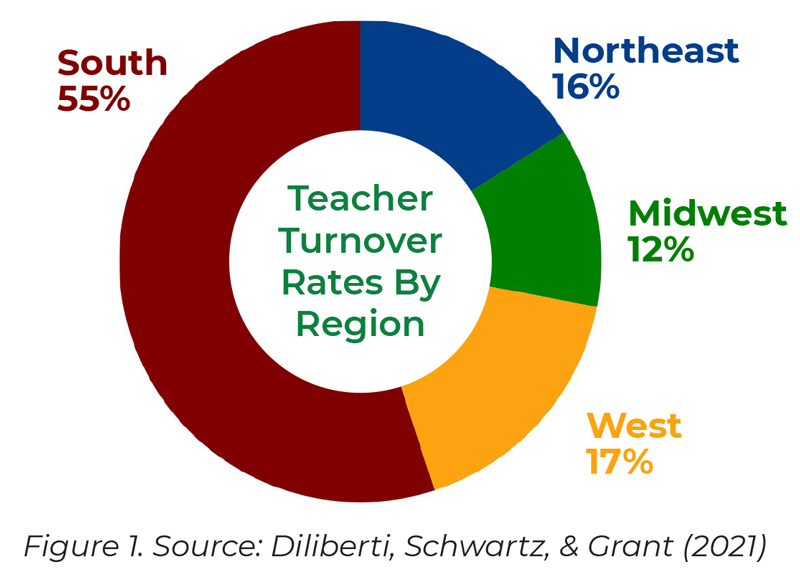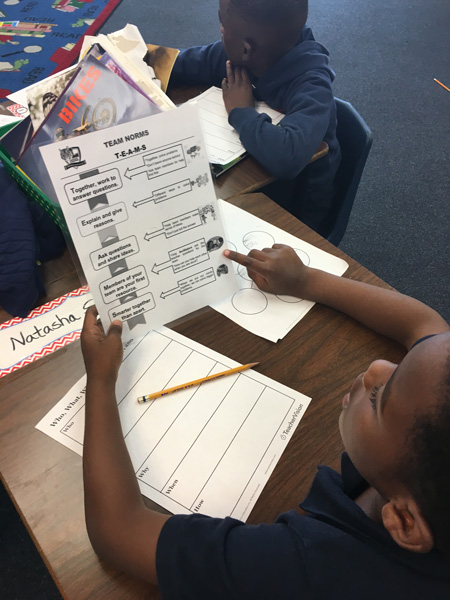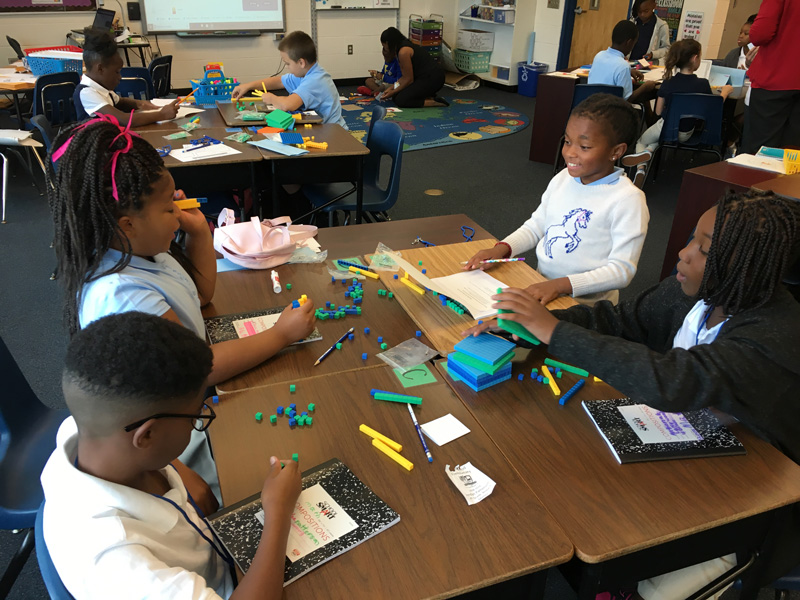
Teachers and leaders at Lakewood Elementary in Pinellas County Schools celebrate improved teacher retention after years of struggling with teachers leaving the profession.
Takeaway
Leaders can reduce teacher turnover by addressing root causes that are within their sphere of influence. This article includes research on the underlying reasons why teachers are leaving the profession. It also highlights a case study about a school that reduced teacher turnover by 78% in one year.
A Story of Teacher Turnover in a School with Low Achievement Scores
This is a real story from the field, but pseudonyms were used to protect anonymity.
During our Applied Research Center team’s first visit as external manager of a school, the principal walked into the meeting room still talking on her radio. “Ms. Brown, can you please help out in Ms. Smith’s room? We don’t have a sub yet.”
The radio crackled back, “I’m already covering in 3rd grade.”
The principal stopped, staring upwards in intense thought. She turned quickly to the door then realized our research team was in the room, waiting for a meeting with her. “I’m sorry. I’ll be right back …”
Then the radio cracked again. “Sub’s here. We got it covered.”
The principal breathed a quick sigh – “O.K. Thanks. I’ll be in a meeting for a while.”
The principal smiled broadly as she sat at the table with us, turning down the volume on her radio. It continued chattering with urgent messages. “It’s just crazy today. Teachers out, kids acting up – just part of being a principal!” She laughed, but her smile could not hide her fatigue and stress.
Our research team was visiting the school to begin several days of a comprehensive needs assessment that would help us understand the root causes for the school’s persistently low performance. It was immediately clear that teacher turnover was causing major disruptions to school operations.
In that year alone, 23 of the school’s 33 teachers had been replaced. The principal told us that her teachers were burned out from serving a student population with 15% who are homeless or in foster care and 100% from low socioeconomic backgrounds. She said that she was powerless to stop the endless turnover of teachers leaving the profession.
This was in 2018 – long before the pandemic. Since then, COVID disrupted every school in the nation, and many schools are still feeling the effects. What became of this school? Was the principal correct in thinking that there was nothing she could do about teachers leaving the profession? I will keep you in suspense for a while, but this story has a happy ending. For now, let’s examine the problem of teacher turnover in more detail.
Teacher Turnover Is a Problem Nationwide
Teacher Turnover Is Not a New Problem
Statewide teacher turnover rates have been fairly consistent, varying by 5% to 8% over the past 35 years (Aldeman, Goldhaber, & Theobald, 2021; Goldhaber & Theobald, 2021; Dee & Goldhaber, 2017). Nevertheless, a more recent RAND study (Diliberti & Schwartz, 2023), indicates that teacher turnover is higher than pre-pandemic levels by 4%. Findings from the 2024 State of the American Teacher Survey (Doan et al., 2024) reveal that 22% of teachers intended to leave their jobs, and 17% intended to leave the profession. These percentages were higher for Black and Hispanic teachers.
Historical trends indicate that teacher turnover increases during periods of economic growth and falling unemployment rates. As the nation continues to recover from the pandemic, it is likely that we will see more teachers leaving the profession (Goldhaber & Theobald, 2021). Districts are responding by making policy changes to incentivize teachers to remain, as well as creating teaching induction pipelines (Diliberti & Schwartz, 2023). Nevertheless, teachers’ perceptions of occupational prestige and job satisfaction are at the lowest levels in 50 years (Kraft & Lyon, 2024).
Where Is Teacher Turnover Most Prevalent?
RAND (Diliberti, Schwartz, & Grant, 2021) reports the rate of teacher turnover ranges from 12% to 17% in the Northeast, Midwest, and West, while the turnover rate in the South is 55%.

Which Schools See Teachers Leaving the Profession at Higher Rates?
The greatest variation in teacher turnover is among different schools. In fact, much of the variation in teacher turnover is explained by three school characteristics (Aldeman, Goldhaber, & Theobald, 2021):
(1) Urbanicity
(2) Percentage of students from low socioeconomic backgrounds
(3) Percentage of Black, Hispanic, and American Indian students
Other researchers agree that teacher attrition rates vary depending on schools and who they serve:
- The teacher turnover rate is greater in schools with more students from low socioeconomic backgrounds, schools where most students are Black, Hispanic, and American Indian, and rural schools (Aldeman, Goldhaber, & Theobald, 2021; Diliberti & Schwartz, 2023).
- Title I schools experience 50 percent more teacher turnover than non-Title I schools (Carver-Thomas & Darling-Hammond, 2017).
Why Is High Teacher Turnover a Problem?
Disruption of education – The disruptions caused by teacher turnover have a negative effect on the quality of instruction, particularly in schools with low achievement scores (Hanushek, Rivkin, & Shiman, 2016).
Higher rates of teacher turnover in some schools – Teacher turnover impacts all students, with some students located in schools that have a higher rate of teacher turnover. For example, the rate of teacher turnover in schools with high concentrations of Black, Hispanic, and American Indian students is 70% higher than in schools with fewer Black, Hispanic, and American Indian students (Carver-Thomas & Darling-Hammond, 2017).
Impact on schools with lower achievement and gaps – School poverty rates are highly correlated to achievement gaps, and schools with higher poverty rates also tend to serve more Black, Hispanic, and American Indian students (Reardon, Weathers, Jang, & Kalogrides, 2021). It is these schools that struggle most to attract and retain skilled teachers (Reardon, 2015). Rates of turnover in schools serving more students from low socioeconomic backgrounds equate to yearly replacement and onboarding of 400 more teachers than in schools serving less students from low socioeconomic backgrounds (Alderman, Goldhaber, & Theobald, 2021).
Why Are Teachers Leaving the Profession?
Teachers cite three main reasons for leaving schools or completely leaving the profession: working conditions (Carver-Thomas & Darling-Hammond, 2017), the lack of respect shown to them as professionals (Streeter, 2021), and stagnant or decreasing academic achievement (Lakewood Elementary: How This Florida School Raised Student Their State Rating from the Lowest to One of the Highest in the State, 2021; Hanushek, Rivkin, & Shiman, 2016).
(1) Working conditions
Working conditions include such factors as stress and health concerns, safety, and work/life imbalance (Streeter, 2021; Diliberti, Schwartz, & Grant, 2021), as well as student behavior (Becoming a School Where All Students Thrive, 2019). One of the most frequently cited problems with working conditions is a lack of administrative support. Teachers who feel their administration is unsupportive are twice as likely to leave than teachers who feel supported (Carver-Thomas & Darling-Hammond, 2017).
(2) Lack of respect as a professional
Teachers want to be respected as professionals and accorded opportunities to exercise teacher agency in their instructional decisions (McChesney & Aldridge, 2019). All too often, however, teachers in schools with low achievement scores must use scripted curricula within highly controlled and compliance-driven classrooms, depriving them of professional agency over their own practice. High-stakes evaluations have also contributed to an increased perception of the loss of professional autonomy (Kraft & Lyon, 2024). But teachers who feel supported by their leaders are more likely to successfully adopt innovations that positively impact their students (Basileo & Lyons 2024).
(3) Stagnant or decreasing academic achievement
Persistently low student achievement may induce teachers to leave the profession, especially those in schools with low performance. This sets up a vicious cycle of disruptions that further degrades the quality of teaching and learning (Hanushek, Rivkin, & Shiman, 2016).
Other factors
There are many other causes of teachers leaving the profession, such as low pay, testing and accountability mandates, family concerns, financial needs, and general dissatisfaction with teaching as a profession (Carver-Thomas & Darling-Hammond, 2017). But these factors are generally beyond the control of principals.
Subscribe for curated education insights delivered every two weeks.
What Can Leaders Do to Fix the Problem of Teacher Turnover?
Teacher turnover is not inevitable, nor is it beyond a school leader’s ability to fix. According to our Applied Research Center’s work partnering with schools across the country, the best places to start are developing your school leadership team’s capacity and determining the root causes you’ll need to tackle together.
Build Your Leadership Team
Results from a survey by the National Association of Secondary School Principals (2021) indicate that one-third of principals are thinking of leaving the profession, with most identifying the teacher shortage and increased workload as issues of extreme concern. Recent studies also show that principal turnover is high, especially in districts in high poverty and rural areas (Diliberti & Schwartz, 2023).
You cannot fix the problem of teacher turnover by yourself through hero leadership – you will only burn yourself out. Your first order of business is to surround yourself with a strong school leadership team who can share the load with you. A strong leadership team is as essential to your well-being as it is to the school.
Distribute leadership to your team so everyone owns improvement in the three areas of concern:
(1) Schoolwide conditions
(2) Teacher professionalism and autonomy
(3) Academic rigor
Analyze 3 Common Root Causes of Teacher Turnover
Next, recognize and deal with the root causes of teacher turnover in your school. The following three root causes are some of the most common. Be honest with yourself when reflecting on the questions below. You may want to assign a rating to each question on a 1-5 point scale and seek evidence to support your thinking (such as classroom observations, teacher surveys, etc.).
(1) Establish Healthful, Safe, and Respectful Schoolwide Conditions
-
-
- Does your school protect the safety and health of teachers and students?
-
-
-
- Are there procedures and routines that all staff and students know, understand, and follow?
-
-
-
- Are you supporting your teachers in creating and reinforcing classroom management practices that foster student self-regulation, mutual respect, and student-led behavior management?
-
-
-
- Are you providing resources for self-care of teachers – and for yourself?
-
(2) Build Teacher Professionalism and Autonomy
Effective teachers are more likely to remain in schools than less effective teachers (Ronfeldt, Loeb, & Wyckoff, 2012); and regular, supportive communication from school leadership encourages teacher professional growth and retention (Borman & Dowling, 2008).
-
-
- Are you and your leadership team visiting classrooms, observing the quality of instruction, and supporting teachers with non-evaluative coaching and feedback to grow their practice?
-
-
-
- Are you providing and protecting collaborative time for teacher planning and mutual support?
-
-
-
- Are your teacher leaders providing coaching and peer support to teachers and professional learning communities?
-
-
-
- Are you intentionally implementing leadership practices that increase teacher agency?
-
Research indicates that mentoring and feedback are essential aspects of professional development that foster teacher retention (Hanushek, Rivkin, & Shiman, 2016); it is also critical to the development and retention of early career teachers (Borman & Dowling, 2008).
(3) Ensure Academic Rigor
Quality instruction is critical to ensuring that all students perform at high academic levels. As student performance improves, teacher efficacy and commitment grow.
-
-
- Are all students in your school receiving rich and rigorous Tier 1 instruction?
-
-
-
- Are you and your leadership team collecting and examining daily evidence of student learning?
-
-
-
- Do you use student evidence of learning to inform your leadership team’s goals and actions to improve instruction each day?
-
Asking these questions will direct your team’s attention to the key systems within your school that directly impact teacher turnover.
Example From the Field: How a School Reduced its Teacher Turnover Rate by 78% in One Year
Returning to the story from the beginning of this article, you will be happy to learn that Lakewood Elementary School in St. Petersburg, Florida overcame the problems besetting them. By attending diligently to systems over which they had control, they transformed their school from having the lowest to one of the highest state accountability ratings in the state.
Lakewood partnered with a team of external consultants for three years. In one year, Lakewood went from 23 teachers leaving to only 5 teachers leaving. In 2021 – despite the pandemic – they replaced only 1 teacher. This case study explains how the school attained such high levels of performance and teacher retention.
A summary of the case study results and its connection to teacher turnover follows.
Elevating Schoolwide Conditions
The environment at Lakewood was not conducive to student learning nor teacher satisfaction, and students often responded to their environment by expressing challenging behaviors. In interviews about the school’s conditions before their partnership with the consulting team members, one teacher said, “It felt like working in a war zone.”
Students fought with one another and walked out of class in the middle of instructional time. The vast majority of students were more than two grade levels behind, according to initial diagnostic testing. Many teachers resigned or transferred out, citing the difficult conditions.
The consulting team members partnered with the school leadership team and teachers to build students’ ownership of their own behavior and self-regulation with student-led teaming structures through the Model of Instruction for Deeper LearningTM.
Instead of focusing on controlling student behavior, Lakewood focused on student-led behavior management strategies and academics, empowering students to engage in their learning by self-tracking their own progress and cheering one another to academic success. Behavior referrals decreased by 160%. See figure 2.

A Lakewood Elementary School student reviews the student-led teaming structures that empower students to track their own learning. As Lakewood students engaged in deeper learning and took ownership of their own behavior, schoolwide conditions improved for both students and teachers.
Referrals for Challenging Behaviors at Lakewood Elementary School, 2018-2021

Figure 2. Referrals are used when students express challenging behavior that is too severe for the teacher to handle through classroom management, which necessitates the school’s behavior team to intervene. Lakewood students had 734 referrals in 2018, before Lakewood and the external consulting team started their partnership. Referrals dropped to 207 in 2019, 84 in 2020, and 81 in 2021 (see Lakewood Elementary: How This Florida School Raised Student Their State Rating Lowest to One of the Highest in the State, 2021).
Elevating Teacher Professionalism and Autonomy

Lakewood’s coaches and leadership team worked together with teachers to create a visible wall to track progress based on data from Instructional Empowerment’s Rigor Classroom Walk. It is part of a non-evaluative tool, Rigor Appraisal, that is the only known tool that deeply measures academic rigor and can predict student achievement on state assessments.
Lakewood teachers did not have as much autonomy as they wanted before the partnership began. According to one Lakewood teacher, “Everything was scripted: how the lesson went, what moment everything was supposed to happen.” What was missing from the PLCs was team collaboration, productive struggle, accountability to student data, and teacher agency.
Through side-by-side coaching support in the classroom and during PLCs, in conjunction with the Lakewood leadership team’s coaching support, the school culture shifted, and more teachers decided to stay. Teacher retention increased by 78% in one year. See figure 3.
Teacher Turnover Rates at Lakewood Elementary School, 2018-2021

Figure 3. Teacher turnover decreased from 23 teachers replaced before Lakewood partnered with the external consulting team (out of 33 teachers total), to only five teachers replaced after one year of partnership and one teacher replaced after three years of partnership (see Lakewood Elementary: How This Florida School Raised Student Their State Rating Lowest to One of the Highest in the State, 2021).
Elevating Academic Rigor

Students at Lakewood Elementary School work in teams on academically rigorous, engaging tasks as part of Instructional Empowerment’s Model of Instruction for Deeper Learning.
As Lakewood students experienced rigor and agency through the Model of Instruction for Deeper Learning, they became more engaged and took ownership of their own learning. Teachers watched in awe as students evolved from dependent learners to independent thinkers, believed in themselves, and invested more effort into their learning. Teacher motivation increased as daily student data became the focus and teachers could see tangible improvements. Student achievement skyrocketed. See figure 4. In three years, Lakewood went from receiving the lowest rating from the state for all traditional public schools to being rated in the top 6% of elementary schools.
Lakewood Elementary School’s Achievement and Learning Gains, 2018-2021

Figure 4. Lakewood increased achievement (proficiency) in all subjects – ELA, math, and science. Lakewood also increased learning gains and learning gains for their lowest 25% in all subjects (learning gain data for science not provided by the state). All data publicly available from the Florida Department of Education (see also Lakewood Elementary: How This Florida School Raised Student Their State Rating Lowest to One of the Highest in the State, 2021).
School Leaders Have the Power to Stop Teacher Turnover
At its core, teacher turnover is a leadership problem. To correct it, you must own those problems that you alone, as a leader, can solve:
(1) Schoolwide conditions
(2) Teacher professionalism and autonomy
(3) Academic rigor
If you focus on these three areas, your teachers will stay – and your students will thrive.
Consider scheduling a meeting with our expert educators to discuss best practices for how to address the unique challenges of teacher retention in your school or district.
About the Author
Dr. Merewyn Lyons
Dr. Merewyn Lyons is a Senior Research Analyst with Instructional Empowerment’s Applied Research Center. Her primary research interest is educational psychology, with a focus on understanding the effect of motivation on teaching, learning, and educational leadership. She is co-author of peer reviewed articles in Frontiers in Education, Quality Education for All, and Sage Open. Dr. Lyons is a member of the Center for Self-Determination Theory, the American Educational Research Association, and the European Association for Research on Learning and Instruction. She is also a retired officer of the United States Navy and a retired K-12 educator.
References
Aldeman, C., Goldhaber, D., Theobald, R. (2021). Examining the dimensions of teacher turnover. (CALDER Flash Brief No. 24-0421). National Center for Analysis of Longitudinal Data in Education Research. https://caldercenter.org/publications/examining-dimensions-teacher-turnover Basileo, L. & Lyons, M.E. (2024). An exploratory analysis of Early Adopters in education innovations. Quality Education for All, 1(1), 158-179. https://doi.org/10.1108/QEA-10-2023-0009
Becoming a School Where All Students Thrive (2019). https://instructionalempowerment.com/wp-content/uploads/2023/04/IE01-141-Case-Study-Moseley-_04-23.pdf
Borman, G. D., & Dowling, N. M. (2008). Teacher attrition and retention: A meta-analytic and narrative review of the research. Review of Educational Research, 78(3), 367-409. https://doi.org/10.3102/0034654308321455
Carver-Thomas, D. & Darling-Hammond, L. (2017). Teacher turnover: Why it matters and what we can do about it. Learning Policy Institute. https://learningpolicyinstitute.org/product/teacher-turnover
Dee, T. S., & Goldhaber, D. (2017). Understanding and addressing teacher shortages in the United States. Brookings. https://www.hamiltonproject.org/papers/understanding_and_addressing_teacher_shortages_in_the_united_states
Diliberti, M. K., & Schwartz, H. L. (2023). Educator turnover has markedly increased, but districts have taken actions to boost teacher ranks. RAND Corporation. https://www.rand.org/content/dam/rand/pubs/research_reports/RRA900/RRA956-14/RAND_RRA956-14.pdf
Diliberti, M. K., Schwartz, H. L., & Grant, D. (2021). Stress topped the reasons why public school teachers quit, even before COVID-19. RAND Corporation. https://www.rand.org/pubs/research_reports/RRA1121-2.html
Doan, S., Steiner, E. D., & Pandey, R. (2024). Teacher well-being and intentions to leave in 2024. RAND Corporation. https://www.rand.org/pubs/research_reports/RRA1108-12.html#document-details
Goldhaber, D., & Theobald, R. (2021). Teacher attrition and mobility over time. Educational Researcher, 20(10), 1-3. https://doi.org/10.3102/0013189X211060840
Hanushek, E. A., Rivkin, S., & Schiman, J. C. (2016). Dynamic effects of teacher turnover on the quality of instruction. (CALDER Working Paper No. 170). National Center for Analysis of Longitudinal Data in Education Research. https://files.eric.ed.gov/fulltext/ED571812.pdf
Kraft, M. A., & Lyon, M. A. (2024). The rise and fall of the teaching profession: Prestige, interest, preparation, and satisfaction over the last half century (EdWorkingPaper: 22-679). Annenberg Institute at Brown University. https://doi.org/10.26300/7b1a-vk92
Lakewood Elementary: How This Florida School Raised Student Academic Proficiency from the Lowest to One of the Highest in the State. (2021). https://instructionalempowerment.com/wp-content/uploads/2023/09/IE01-140-01-S-Lakewood-09-23.pdf
McChesney, K., & Aldridge, J. M. (2019). What gets in the way? A new conceptual model for the trajectory from teacher professional development to impact. Professional Development in Education, 47(5), 834-852, https://doi.org/10.1080/19415257.2019.1667412
National Association of Secondary School Principals. (2021, December 8). NASSP survey signals a looming mass exodus of principals from schools. https://www.nassp.org/news/nassp-survey-signals-a-looming-mass-exodus-of-principals-from-schools/
Reardon, S. F. (2015). School segregation and racial academic achievement gaps. (CEPA Working Paper No.15-12). Stanford Center for Education Policy Analysis. http://cepa.stanford.edu/wp15-12
Reardon, S. F., Weathers, E. S., Fahle, E. M., Jang, H., & Kalogrides, D. (2021). Is separate still unequal? New evidence on school segregation and racial academic achievement gaps. (CEPA Working Paper No. 19-06). Stanford Center for Education Policy Analysis. https://cepa.stanford.edu/wp19-06
Ronfeldt, M., Loeb, S., & Wyckoff, J. (2012). How teacher turnover harms student achievement. (CALDER Working Paper No. 70). National Center for Analysis of Longitudinal Data in Education Research. https://caldercenter.org/sites/default/files/Ronfeldt-et-al.pdf
Streeter, L. G. (2021, October 18). Why so many teachers are thinking of quitting. The Washington Post Magazine. https://www.washingtonpost.com/magazine/2021/10/18/teachers-resign-pandemic/
Subscribe for curated education insights delivered every two weeks.
About Instructional Empowerment
Our mission is to end generational poverty and eliminate achievement gaps through redesigned rigorous Tier 1 Instruction that ensures deeper learning for ALL students.




